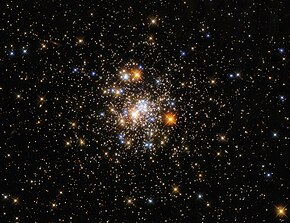NGC 6717
Appearance
| NGC 6717 | |
|---|---|
 Hubble Space Telescopeimage of NGC 6717 | |
| Observation data (J2000epoch) | |
| Constellation | Sagittarius |
| Right ascension | 18h55m06.04s[1] |
| Declination | −22° 42′ 05.3″[1] |
| Distance | 23.8 ± 1.6 kly (7.3 ± 0.5 kpc)[2] |
| Apparent magnitude(V) | +9.28[3] |
| Physical characteristics | |
| Other designations | NGC6717,Cr395, ESO 523-14, GCl 105[1] |
NGC 6717(also known asPalomar 9) is aglobular clusterin theconstellationSagittarius,and is a member of thePalomar Globular Clustersgroup. Palomar 9 was discovered byWilliam Herschelon August 7, 1784. It is located about 7,300 parsecs away fromEarth.[2]
The globular cluster, which has anapparent magnitudeof 9.28 and diameter of 9.9 arcminutes, is located just south of the starν2 Sagittarii.The bright star region on the north-eastern edge has the separate designationIC 4802.
References
[edit]- ^abc"NGC 6717".SIMBAD.Centre de données astronomiques de Strasbourg.Retrieved30 December2016.
- ^abOliveira, R. A. P.; Ortolani, S.; Barbuy, B.; Kerber, L. O.; Maia, F. F. S.; Bica, E.; Cassisi, S.; Souza, S. O.; Pérez-Villegas, A. (2022). "Precise distances from OGLE-IV member RR Lyrae stars in six bulge globular clusters".Astronomy & Astrophysics.657:A123.arXiv:2110.13943.Bibcode:2022A&A...657A.123O.doi:10.1051/0004-6361/202141596.S2CID239998638.
- ^Frommert, Hartmut."NGC 6717, Palomar 9".seds.org.Retrieved30 December2016.
External links
[edit]
